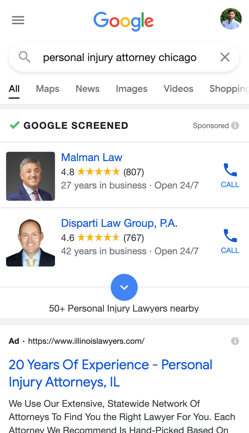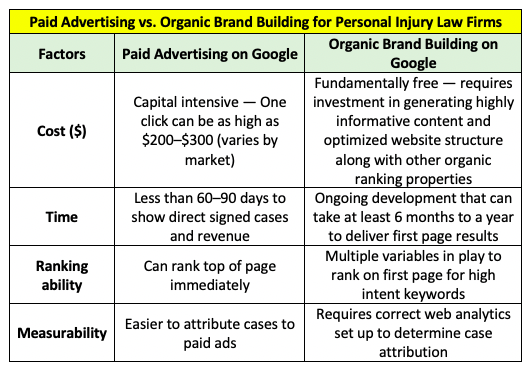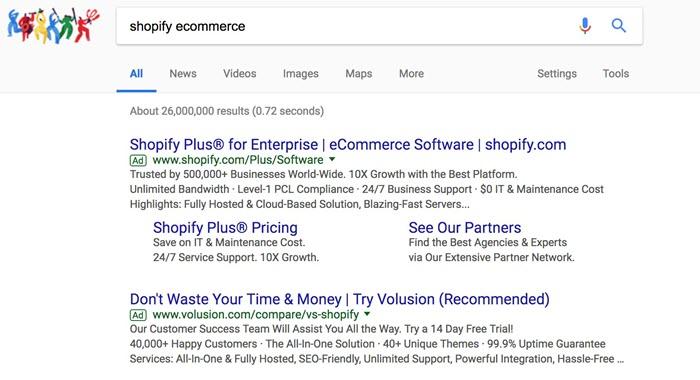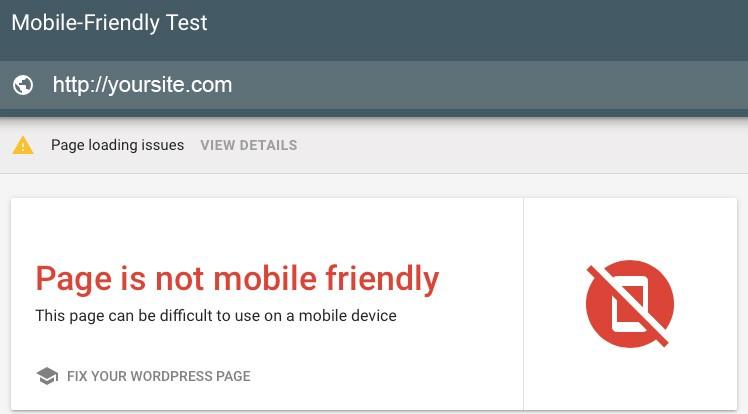Table of Contents
It’s no secret that the personal injury legal area is one of the most competitive in the country from a marketing standpoint. This is a significant problem for lawyers who want to stand out in a crowded field and gain the trust of their audience.
We’ve put together a thorough guide to equip attorneys with the holistic information they need to acquire more cases while establishing their brands for long-term growth, based on our years of experience helping personal injury law firms scale their practices successfully and profitably.
This guide serves as a marketing plan for personal injury law firms of any size and solo practitioners looking to expand their reach in their local market.
Second, it will equip attorneys who are unsure about their existing marketing and advertising strategy with in-depth marketing knowledge via case studies.
Why Personal Injury Law is a Unique Business
Negotiate and Advocate — As a personal injury lawyer, you will nearly always be negotiating. Almost every party you’ll encounter during an individual injury case will require your negotiation abilities — the court, insurance companies, clients, adjusters, opposing attorneys, and so on.
Diverse Clientele – personal injury (whether genuine or imagined) is prevalent across all social classes. As a result, when practicing law, a personal injury lawyer gets the opportunity to encounter a wide range of persons, from the random citizen who slips and falls on a banana peel to the charitable billionaire who is sued for negligence.
Every case is unique – even if claims are similar, customers and their experiences are never the same. As a result, this type of lawyer will have to constantly update their methods and arguments and invent new ones on the fly.
Satisfaction – Because of the nature of their work, personal injury lawyers can watch a case from start to finish. Furthermore, they can be by a client’s side from when they claim until the disagreement is resolved, which provides great satisfaction.
Main Personal Injury Law Business Challenges
Jury Trials’ Delay
The most significant setback has been the postponement of jury trials. Giving a customer their day in court is frequently the only option to make an insurance company compensate a client appropriately. Because of the delay, insurance firms have been able to postpone justice by refusing to negotiate cases that have been delayed.
Personal injury lawyers are coming up with new tactics to challenge insurance companies ‘running out the clock.’ Putting deadlines on requests and then retracting them, for example, can work in some instances. In some cases, agreeing to binding arbitration can be beneficial. The ideal tactic is to keep a case going early in the hopes of gaining a trial date as soon as the jury trials commence.
Due to the indefinite suspension of jury proceedings by state and municipal administrative decisions, there is no timetable for civil jury trials, such as personal injury.
Political Containment
Many laws have been passed in the last two decades to limit culpability when someone is wounded or killed due to the negligence of another person or corporation. But, unfortunately, this has happened and continues to happen, and most individuals are unaware of it until they want legal assistance.
As a result, many lawyers have been obliged to turn off injured clients over the years. As a result, many people who have been gravely hurt or lost a family member due to someone else’s negligence cannot locate a lawyer who will take their case.
Numerous regulations have been altered to dramatically limit the amount of money injured persons should be reimbursed, ranging from premises liability to medical malpractice, auto accidents, and defective products. As a result, personal injury lawyers face a significant barrier in obtaining client satisfaction.
Defending Your Law Firm
COVID 19 has resulted in a significant reduction in the number of personal injury cases. It’s because fewer people are commuting to work, mingle, and dine and enjoy themselves, resulting in fewer miles driven and fewer accidents.
The problem here is to protect the firm’s attorneys and personnel from the infection and the firm’s financial soundness. Furthermore, many clients with cases are reluctant to travel to their lawyer’s office for an in-person appointment, limiting revenue potential.
Companies that provide internet video conferences have a particular competitive advantage. Documents, such as tax files will likely be submitted online in the future to support claims, such as lost wage claims. In addition, many law firms have begun to use remote work and home office capabilities.
Fighting Legal Advantaged Insurers is Difficult
Another big challenge is to fight court actions against insurance companies who are less likely to pay acceptable settlement payments.
According to their statistics and algorithms, it’s worth investigating the matter in court or hoping that the plaintiff’s attorney won’t take the case that far. On the other hand, health insurance companies are pursuing their subrogation liens more vigorously, and the federal ERISA law has given many of them an insurmountable advantage.
These characteristics make it more challenging to obtain new personal injury cases, make it more difficult to settle for fair sums, and result in a lesser net settlement for the client and attorney, after all, is said and done.
Fierce Competition
The competitive nature of the field is the main hurdle that personal injury attorneys confront today. When a person is harmed in an accident, personal injury attorneys have a plethora of alternatives. As a result, a personal injury attorney is trying to attract business everywhere a possible client looks: on television, radio, billboards, Facebook, Instagram, YouTube, even the backs of buses.
As a personal injury attorney, you are constantly evaluating how you can stand out, drive business, and compete with the big-spender personal injury ads. Yes, it can feel overwhelming and unattainable at times.
When dealing with clients, personal injury lawyers must be both professional and personal. Not every client desires a large firm that promises “huge” outcomes. Not every client feels at ease phoning an office where they have no idea who will be handling their case. Furthermore, and perhaps most crucially, not every client is interested in what you have to offer. One of the most challenging obstacles for today’s injury lawyers is the competitive nature of the field.
Obstacles to Mass Outreach
One of the most challenging tasks for minor personal injury law companies is getting their message out to potential clients. There are numerous significant corporations with limitless advertising budgets. You can always see them on TV or hear about them on the radio. While small legal firms can use social media to promote themselves, it does not have the same reach as traditional media.
Small legal firms provide personalized assistance for customer care, such as visiting with your attorney in person. However, many major law firms may not offer the same degree of service to their clients. If you’re shopping, for example, you might think of heading to the big box store because you’re familiar with it and believe it’s the best option, but a friend tells you about a bit of boutique with more unusual things and kind employees.
Cons of Personal Injury Law Business
Emotional Luggage – For the majority of our customers, the accident completely disrupted their lives. As a result, the personal injury lawyer is dealing with an emotionally unstable client who will most likely act (and accept settlements) based on their emotions. Therefore, the lawyer must be skilled at negotiating and dealing with emotions.
Limitations — the task itself is, of course, minimal in terms of the end goal. While the journey might be compared to a roller coaster, the ultimate result is always the same – getting the best settlement for the client. Clients with severe physical issues can make lawyers feel powerless in some instances.
Lack of Efficiency — The process of filing a personal injury claim is slow, cumbersome, and inefficient. The lawyer must work around the edges to achieve the best possible result, which can be very frustrating over time.
Personal Injury Law Firm Marketing Strategies
Paid Advertising vs. Organic Brand Building
It’s critical to grasp the differences between paid digital advertising and organic brand creation before we get into the nitty-gritty of what it takes to construct an online presence for a personal injury law business.
To be clear, we feel both are critical components of a successful digital marketing plan. However, not every legal firm or solo practitioner is set up to reap the value from both, depending on marketing investment or operational capabilities. Understanding the differences between them can aid in goal prioritization and impact measurement.
To assist us in comprehending the distinctions between the two, we’ll use Google’s search engine as an example. For example, here are the results of a mobile search for the phrase “personal injury attorney Chicago”:

On a mobile device, each screenshot shows the results of up to three thumb scrolls. First, local services ads and search text ads are among the sponsored listings before the map. Next, the organic website listings are closest to the user’s location, followed by map listings.
Based on the amount of real estate available for ads on this search engine results page, one may believe that focusing on running ads on Google should be a top priority. While there is some validity to this, not every law firm or solo practitioner can compete with the level of marketing investment made by other companies. In this table, we break down the comparison:

It makes it reasonable to continue investing in sponsored ads on Google search if a legal firm has had success with them. However, going the organic traffic route with original, helpful content initially and learning about what their audience finds beneficial is recommended for a law practice that does not have much money to invest upfront.
Time is money in the legal profession; thus, the critical question we’d like to get an early answer to is:
Do you want to market your law practice with a lot of money or with a lot of time?
A capital-intensive strategy would prioritize advertising efforts that require less attorney involvement over organic ones. In contrast, a time-intensive approach would require attorneys to create compelling content, record videos, and provide beneficial information on the internet to build credibility and trust.
We are not advising that you choose one method over the other because they are both necessary. Still, this becomes a critical decision moving ahead based on your circumstances and existing digital marketing position.
Set “Cost Per Case” Objectives
When I inquire what their desired Cost Per Case (CPCase) is, you might be startled by the uneasy face I get from some lawyers. It might be challenging to respond in their defense because a legal lawsuit could be worth $2,000 or millions of dollars. The practice field also matters because a car accident attorney may only want to pay $500 for each case, whereas a Mesothelioma attorney may be willing to pay $100,000 per case.
CPCase is an excellent approach to setting goals for yourself and your company. Drop everything and start with this if you don’t know what your company’s intended CPCase is. Even if it’s an arbitrary figure, it’ll help you make marketing decisions and reduce the impact of not measuring instant ROI. If you don’t know how to access this number or can’t get a response from the law firm, I recommend doing the following steps:
- Find the average lawsuit settlement value for the firm over the last two years. (Advanced: To eliminate outlier data, utilize Excel’s TRIMMEAN function.) You don’t want to shave too much off with the percentage of outliers you employ.)
- To get three different CPCase values, multiply your average case settlement by 10%, 20%, and 30%, respectively.
- Show the owner or partners these three numbers and explain how you arrived at the CPCase. They should next decide whether they are willing to spend 10%, 20%, or 30% of the typical case on marketing (or anywhere in-between). Because that is a business choice unique to each company, I cannot offer advice on what is best for you.
Google Brand Name Bidding
I’m sure you’ve heard of PPC (and if not, you sure are in the right place to learn). Bidding on your brand name is the easiest and best investment you can make, as complex and technical as PPC can be. The average cost per click on a brand name is between $.50 and $3.
“Why would I spend money on brand searches if I already show up in organic?” is probably the first question that comes to mind. Great question, and here’s the first and most important reason:
Brand protection is essential. If you don’t bid on your brand name, your competitors will, which means the first message a user sees will be your competitor’s, not yours. Do you want others attempting to steal your clients to have the advantage of being the first to view them? I wouldn’t do that. Here’s a real-life illustration of this. Look at the second ad, which would typically be the first result on the page with the slogan “Don’t Waste Your Time and Money” if Shopify wasn’t bidding on their brand name. That would be negative news.

There are also advantages to advertising on your terms, such as selecting the message shown to potential customers. If you rely on organic results, you’re allowing Google to decide what a potential client sees. I don’t know about you, but I’d rather talk about my company than let Google decide how to do it.
When you consider the value you get for your money, brand bidding is pretty inexpensive. You’ve worked hard to establish a brand identity; now is the time to defend it!
Go Mobile

More than half of all searches are conducted on a mobile device. That shouldn’t come as a surprise; consider how often you go into your pocket or bag to Google something on your mind (sorry, Bing). However, for many organizations, the mobile movement is no longer a trend but a need.
A user is five times more likely to abandon a site that isn’t mobile-friendly. “Mobile-Friendly” refers to a fully working responsive web design instead of a site with a mobile-specific URL. It’s also vital to have a fast website load time: a 10-second page load time has a 123 percent greater bounce rate than a 1-second page load time.
To make sure your website is ready for the mobile-first world, follow these steps:
- This one should go without saying: make sure your website is responsive, or at the very least, mobile-friendly. If it isn’t, you’ll need to upgrade your website.
- Google’s approval: Test your mobile-friendliness with Google. This tool will explain why your page is or is not mobile-friendly in great detail.
- Examine your speed. To test your mobile page speed, go to this website. If your rate is in the red, follow the instructions to restore it to green. Some recommendations, such as image optimization or caching concerns, can be as simple as installing a few WordPress plugins.
Final Thoughts
These strategies for a personal injury law firm marketing program will prove to be very successful if implemented correctly.
Being personal injury lawyers, our clients must see what we can do for them and help them recover from their accidents.
We need to get the correct information about our services and show what we can do while bringing in business for the future.
These marketing tools are the best ones I have found for our business because they show our expertise through case studies.
